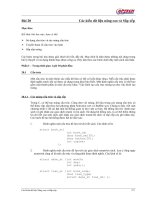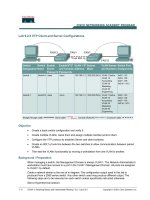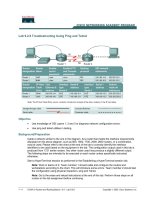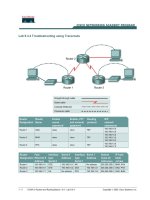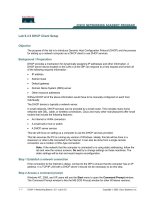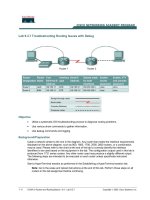Lecture Maya dynamics basics: Lab 9 - Khieu Van Bang
Bạn đang xem bản rút gọn của tài liệu. Xem và tải ngay bản đầy đủ của tài liệu tại đây (1.62 MB, 26 trang )
Author: Khieu Van Bang
Email:
Maya Dynamics Basics
Lab 9: Particle Goal
CONTENTS
Overview Particle Goal :
What is Particle Goal ?
What we can do with Particle Goal ?
Integrated with Particle Goal :
Create Integrated with Particle Goal.
Practical situations.
Exercise:
Create a virtual experiments.
Particle Goal
1) OVERVIEW PARTICLE GOAL
PARTICLE GOAL
1.1) Goal ?
Working with Particle Goal ( A goal is an object that particles follow or move towards. You
can use goals to give trailing particles a flowing motion that’s hard to generate with other
animation techniques. The trailing particles move as if connected to the goal by invisible
springs. In the context of goals, soft bodies are considered particles ).
PARTICLE GOAL
1.2) What is Particle Goal ?
Particle objects are useful as goal objects because of the many techniques available for
animating particle motion. You can’t add a goal to individual particles of the particle object,
but you can control how influential each particle is on the trailing object.
If the goal is a particle object, its particles attract the particles of the trailing object one for
one as the animation plays. If particles in the objects do not die, the trailing particles follow
goal particles based on the creation order.
If particles in either object die, the preceding scheme no longer applies. You can no longer
visually predict which trailing particle will follow a particular goal particle.
If the trailing particle object has more particles than the goal object and particles don’t die in
either object, the extra particles follow the first-created particles of the goal.
For instance, suppose you create a goal object with two
particles and a trailing object with four particles. The four
particles would move toward the two particles like this:
PARTICLE GOAL
1.3) What is Multiple goals ?
You can use more than one goal object to affect a particle object. For each goal
object, the trailing particle object has a goal weight that sets the relative weighting
of the attraction. If the goal weights are the same, each goal object attracts the
trailing object with equal strength. The trailing object moves to a position between
the two goal objects, typically oscillating back and forth before coming to
equilibrium.
If the goal weights differ, each goal object attracts the trailing object with different
strength. The trailing object comes to rest at a position closer to the goal with the
higher goal weight.
PARTICLE GOAL
1.4) What we can do with Particle Goal?
Cars
Insect swarm
Virtual experiments
Waterfall
Fantasy effect
PARTICLE GOAL
1.5) Create a Particle Goal.
Step 1:
o Select the particle object you want to be affected by the goal.
o To select a soft body rather than a conventional particle object, you can
select the soft body’s original geometry or its child particle object.
Step 2: Shift-select the object you want to become the goal.
Step 3: Select Particles > Goal.
Step 4: To adjust the goal’s influence, see Edit goal attributes.
Step 5: Play the animation to see the particles move towards the goal.
1
2
PARTICLE GOAL
1.5) Create a Particle Goal.
Goal Weight:
o The goal weight sets how much all particles of the trailing object are
attracted to the goal.
o You can set goal weight to a value between 0 and 1. A value of 0 means
that the goal’s position has no effect on the trailing particles. A value of
1 moves the trailing particles to the goal object position immediately.
Use Transform as Goal:
o Makes particles follow the object’s transform rather than its particles,
CVs, vertices, or lattice points.
Particle Goal
2) INTEGRATED WITH PARTICLE GOAL
INTEGRATED WITH PARTICLE GOAL
Create Integrated with Particle Goal.
o nParticle, Goal, Expression, Fields, Instanter.
o Soft Body, Rigid Body, Goals, Instanter.
o …
Mudballs med goals
Green sweat
Goo blowoff
INTEGRATED WITH PARTICLE GOAL
Practical situations
o nParticle, Goal, Expression, Fields, Instanter.
Goal
Fields
Bee 1
Bee 2
Bee 1
Bee n
Bee n
Bee 2
nParticle + Instanter
PRACTICAL SITUATIONS
2.1) Simulation Basic Object.
Modeling Object.
Create animation.
Export file.
PRACTICAL SITUATIONS
2.2) Create a Particle System.
Create Plan.
Create emitter.
PRACTICAL SITUATIONS
2.3) Creating Particle Goal.
Select Object and Particle then Click Dynamics > Particles > Goal.
PRACTICAL SITUATIONS
2.4) Edit attributes.
Add attributes.
Write code in Expression.
1
3
2
4
5
6
PRACTICAL SITUATIONS
2.4) Edit attributes.
Edit Goal.
PRACTICAL SITUATIONS
2.4) Edit attributes.
Edit Expression.
PRACTICAL SITUATIONS
2.5) Adding Fields.
PRACTICAL SITUATIONS
2.6) Particle Instancer.
PRACTICAL SITUATIONS
2.6) Particle Instancer.
PRACTICAL SITUATIONS
2.6) Particle Instancer.
Particle Goal
2) EXAMPLES
EXERCISE
Create a virtual experiments.
Molecular run when power off
Molecular run when power on
EXERCISE
How to ?
Step 1: Modeling Objects.
Step 2: Create four Emitter(Na+; Cl-; H+, O- );
Step 3: Create Particle Gold.
Step 4: Create Particle Instancer.
Molecular run when power off
Molecular run when power on

